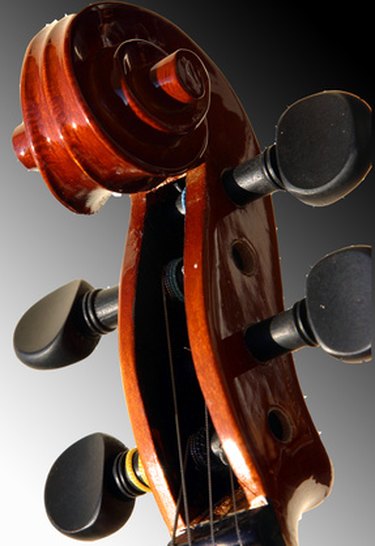Things You'll Need
1 1/4-inch walnut or ebony dowel
1 wooden ball, approximately 3/4 inch diameter
Saw
Drill
1/4-inch wood bit
1/16-inch wood bit
Wood glue
Violin peg shaver

Today's machine tuning pegs are sophisticated, precision instruments. But for thousands of years before tuning machines were invented, humans used simple friction pegs to keep stringed instruments in tune. Properly made, these pegs can do an amazingly good job of holding the right string tension, although they do require a little more patience than tuning machines. In order to work properly, wooden tuning pegs need to be carefully tapered, so that they are wider at the button end and narrower at the opposite end. To achieve that taper, you'll need to use a tuning peg shaver.
Step 1
Cut the dowel to the length required for your instrument. Generally, this will be long enough to go all the way through the head stock of the instrument and protrude about 1/3 inch out the other side. Leave enough length so that you can comfortably turn the tuning knob in back. For an open peg box, the peg will need to be long enough to go all the way through the peg box and into a hole on the opposite side.
Video of the Day
Step 2
Drill a 1/4-inch hole about 1/4 inch down into the wooden ball. Make sure the hole points straight toward the center of the ball.
Step 3
Test to make sure the dowel fits snugly into the hole in the ball.
Step 4
Put a drop or two of glue into the hole, and fit one end of the dowel into the hole. Wipe away any excess glue that squeezes out of the hole.
Step 5
Allow the glue to cure completely, overnight if possible.
Step 6
Hold the peg by the ball, and place the other end into the violin peg shaver until it just contacts the blade. Rotate the peg clockwise so the shaver begins to shave off excess wood.
Step 7
Press the peg slightly deeper into the shaver, continuing to turn it clockwise. Continue this process, pressing lightly on the peg, to taper the dowel.
Step 8
Stop shaving every now and then to check the peg for fit in the appropriate hole in the instrument. The fit should be quite snug when the end of the dowel is in the proper position, but not so tight that you can't turn it.
Step 9
Drill a 1/16-inch hole in the dowel to accept a string. If your instrument has a standard headstock, this should be about a little less than 1/4 inch down from the free end of the dowel. If your instrument has an open peg head, the hole should be about in the middle of the dowel.
Tip
This design builds a ball-end friction peg, similar to those used in traditional Indian stringed instruments. You can work the ball with a rotary sander or with woodcarving tools to create a differently shaped knob. If you created the peg holes in the instrument, you can use the peg reamer tool to make sure the peg shaver is set to the right angle. Just insert the reamer a little ways into the shaver (without turning the reamer) and adjust the blade angle to follow the taper of the reamer. If you like, you can stain the peg using a water-based stain. Do not use any kind of gloss or oil-based finish on it, however.
Warning
Make sure you use a dense, hard wood to make your pegs. Soft or open-grained woods will tend to shred in the shaver. Check your peg frequently for proper fit as you shave the taper. If you shave the peg too narrowly, you will have to throw it away and start over.
Video of the Day